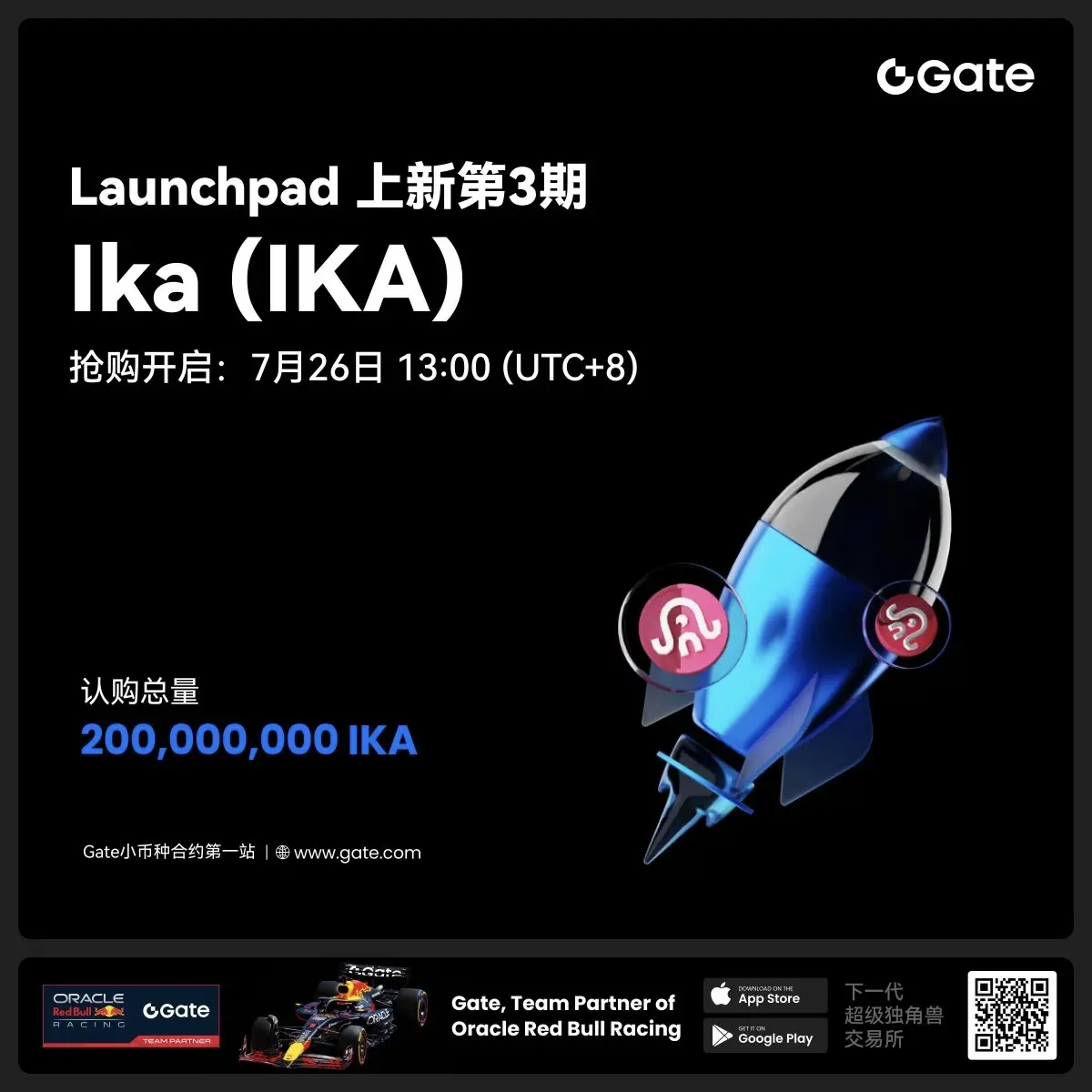- 話題1/3
59564 熱度
48841 熱度
2285 熱度
17549 熱度
151 熱度
- 置頂
- 🎉 親愛的廣場小夥伴們,福利不停,精彩不斷!目前廣場上這些熱門發帖贏獎活動火熱進行中,發帖越多,獎勵越多,快來GET你的專屬好禮吧!🚀
1️⃣ #GateLaunchpad上线IKA# |IKA認購體驗
在Gate廣場帶話題曬出你的IKA Launchpad認購體驗,4位幸運分享者講瓜分$200分享獎池!
詳情 👉️ https://www.gate.com/post/status/12566958
2️⃣ #ETH冲击4800# |行情分析預測
大膽發帖預測ETH走勢,展示你的市場洞察力!10位幸運用戶將平分0.1 ETH 獎勵!
詳情 👉️ https://www.gate.com/post/status/12322403
3️⃣ #创作者活动第二期# |ZKWASM話題
在廣場或推特發布與 ZKWASM 或其交易活動相關的原創內容,瓜分4,000枚ZKWASM!
詳情 👉️ https://www.gate.com/post/status/12525794
4️⃣ #Gate广场征文活动第二期# |ERA話題
談談你對ERA的觀點/體驗,參與並推廣活動,700 ERA大獎等你贏!
詳情 👉️ https://www.gate.com/post/status/12361653
5️⃣ #MBG任务挑战# |MBG話題
分享你對MBG的洞察,積極參與和推廣MBG活動,20位小 - 親愛的廣場用戶們, #Gate 2025年中社区盛典# 投票中!🔥
🙌 廣場內容達人TOP40榜單新鮮出爐!速速圍觀榜單,爲你喜愛的達人瘋狂打call吧:
www.gate.com/activities/community-vote
每天完成【廣場】互動任務可獲得助力值,每投出30助力值即可參與抽獎一次!
iPhone 16 Pro Max 512G、金牛雕塑、潮流運動套裝、合約體驗券、熱門幣種等你抽!
助力越多,中獎機率越大,下一個抱走iPhone 16的錦鯉就是你!🧧
別猶豫,帶上你的“歐氣”,爲達人衝榜贏大獎!
https://www.gate.com/announcements/article/45974
- 🎉 Gate 廣場 IKA Launchpad 發帖活動來襲!🎉
Gate Launchpad 認購 IKA 最後24小時!曬出你的認購體驗,和大家一起分享,每個人都有機會瓜分 $200 獎池!
🎁 4位幸運分享者*$50合約體驗券每人!
🧐 如何參與:
1.在廣場發帖,帶上 #GateLaunchpad上线IKA# 標籤
2.曬出你的認購截圖 或 分享你的獨特認購小竅門/心得或趣事
3.保證帖子大於50字,內容有趣有料,原創,集齊至少3個互動(點讚/評論/轉發)
IKA認購連結:https://www.gate.com/launchpad/2336?downgarde=true
活動時間:7月28日 12:00 - 7月30日 24:00 (UTC+8)
趕快加入,分享你的精彩時刻,你就是下一個幸運兒!
- 📢 Gate廣場 #创作者活动第二期# 正式開啓!
聚焦 ZKWASM 系列活動,分享你的觀點,瓜分 4,000 枚 $ZKWASM!
ZKWASM 作爲 zk 公鏈先鋒,正在 Gate 平台重磅推廣!
三大活動聯動上線:Launchpool 認購、CandyDrop 空投、Alpha 專屬交易——不要錯過!
🎨 活動一:發布廣場貼文,贏內容獎勵
📅 時間:7月25日 22:00 - 7月29日 22:00(UTC+8)
📌 參與方式:
- 在 Gate 廣場發布與 ZKWASM 或其三大活動相關的原創內容(不少於 100 字)
- 添加標籤: #创作者活动第二期# #ZKWASM#
- 附本人參與 Launchpool/CandyDrop/Alpha 的截圖(如認購、空投或交易)
🏆 獎勵設置:
- 一等獎(1名):1000 枚 $ZKWASM
- 二等獎(2名):500 枚 $ZKWASM
- 三等獎(10名):100 枚 $ZKWASM
📋 評選標準:內容質量、互動量、項目相關性,附活動參與截圖者優先。
📢 活動二:發推贏傳播力獎勵
📌 參與方式:
- 在 X(推特)發布與 ZKWASM 或三大活動相關的原創內容(不少於 100 字)
- 添加標籤: #ZKWASM # GateSquare
- 填寫登記表 👉 https://www.gate.com/quest
- 📢 Gate廣場 #MBG任务挑战# 發帖贏大獎活動火熱開啓!
想要瓜分1,000枚MBG?現在就來參與,展示你的洞察與實操,成爲MBG推廣達人!
💰️ 本期將評選出20位優質發帖用戶,每人可輕鬆獲得50枚MBG!
如何參與:
1️⃣ 調研MBG項目
對MBG的基本面、社區治理、發展目標、代幣經濟模型等方面進行研究,分享你對項目的深度研究。
2️⃣ 參與並分享真實體驗
參與MBG相關活動(包括CandyDrop、Launchpool或現貨交易),並曬出你的參與截圖、收益圖或實用教程。可以是收益展示、簡明易懂的新手攻略、小竅門,也可以是現貨行情點位分析,內容詳實優先。
3️⃣ 鼓勵帶新互動
如果你的帖子吸引到他人參與活動,或者有好友評論“已參與/已交易”,將大幅提升你的獲獎概率!
MBG熱門活動(帖文需附下列活動連結):
Gate第287期Launchpool:MBG — 質押ETH、MBG即可免費瓜分112,500 MBG,每小時領取獎勵!參與攻略見公告:https://www.gate.com/announcements/article/46230
Gate CandyDrop第55期:CandyDrop x MBG — 通過首次交易、交易MBG、邀請好友註冊交易即可分187,500 MBG!參與攻略見公告:https://www.gate.com/announcements
數據揭祕:加密新項目上線4大錯覺與成功關鍵
破解加密新項目上線的四大錯覺:數據揭示的真相
在加密貨幣圈子裏,人們常常對新項目的上線策略有許多固有觀念。然而,一項針對2025年40次主要代幣發行的深入研究,分析了5萬個數據點,結果頗爲出人意料。這項研究揭示了一些廣爲流傳的觀點實際上是錯誤的。
參與度的誤區
許多項目方熱衷於追求社交媒體上的各種指標,如點讚、轉發、回復和曝光量。他們投入大量資金用於參與式營銷、任務平台和購買粉絲。然而,研究顯示這些指標與代幣價格表現幾乎沒有關聯。
回歸分析表明,參與度指標與價格表現的相關係數R²僅爲0.038。實際上,點讚、評論和轉發與價格表現呈輕微負相關。這意味着參與度更高的項目有時表現反而更差。
唯一顯示出微弱正相關性的是發布前一周的轉發量,但相關性也很弱。這表明,花費大量資金在所謂的"參與度"上可能是一種無效投資。
低流通量的迷思
很多人認爲以極小的流通供應量發行代幣可以制造人爲稀缺性,從而推高價格。但研究數據顯示,初始流通量佔總供應量的百分比與價格表現沒有顯著關聯。
真正重要的是初始市值的美元價值。數據顯示,初始市值每增加2.7倍,第一個月的價格表現就會下降約1.56%。這種關係如此緊密,幾乎可以說是因果關係。
風險投資支持的錯覺
普遍觀點認爲,獲得知名風投的大額融資會帶來代幣價格的飆升。然而,研究數據顯示,融資金額與代幣表現之間實際上沒有統計學上的顯著關係。
籌集的資金越多,通常意味着估值越高,也就意味着需要克服更大的拋售壓力。額外的資金並不會自動轉化爲更好的代幣表現。
炒作時機的誤區
傳統觀點認爲應該將重要消息留到項目啓動周發布,以創造最大的"FOMO"氛圍。但數據顯示,事實恰恰相反。
研究發現,那些能持續保持良好表現的項目,往往在啓動周之前就建立了知名度。他們明白,啓動前的關注能帶來真正的買家,而啓動周的關注往往只是帶來短暫的熱度。
真正有效的方法
既然上述傳統觀點被證明是錯誤的,那麼什麼才是真正重要的呢?
實際產品效用:能自然生成內容的項目表現更好,因爲它們的產品能持續創造有價值的內容。
交易留存率:在初始熱潮過後仍能保持交易量的代幣,其價格表現明顯更佳。
合理的初始市值:這是成功的最強預測指標。以合理估值上市的項目更有增長空間。
真實的溝通:與產品相匹配的一致語氣,以及真誠、實事求是的更新,往往能帶來更好的結果。
爲何會出現這些誤解?
這種認知偏差並非惡意,而是源於社交媒體的結構性問題。這些平台往往獎勵的是參與度,而非準確性。吸引眼球的內容比真實數據更容易獲得關注。
此外,許多所謂的專家實際上從未親自發行過代幣。他們只是在評論一個未曾親身經歷過的過程。
成功項目的實際做法
根據數據,成功的項目通常遵循以下原則:
以某網路爲例,他們專注於技術解釋和教育性內容,結果在上線後第一周就上漲了150%。這並非因爲他們擁有海量粉絲,而是因爲他們真正激發了人們對其創新的興趣。
相比之下,那些在任務平台和參與式營銷上大量投入的項目,其代幣往往因缺乏真正的理解和關注而表現不佳。
諷刺的是,盡管許多人試圖迎合社交媒體算法,但真正成功的卻是那些默默構建有用產品並明智發布的項目。透明度和專注於產品驅動的內容策略往往能帶來持續的良好表現。